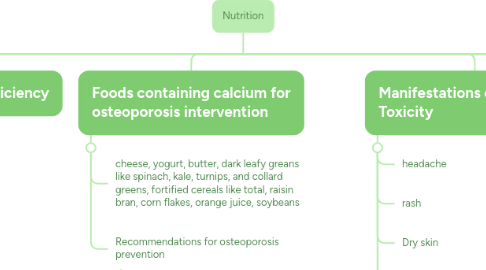
1. Indications of dietary deficiency
1.1. fatigue
1.2. dizziness
1.2.1. decreased vision
1.3. wt loss
1.4. slow growth
1.5. loss of muscle
1.5.1. muscle twitching
1.6. weakness
1.7. swollen red tongue
1.8. bone loss
1.9. in kids: rickets,
1.10. slow healing
1.11. Skin tenting
2. Teaching about vitamins & minerals
2.1. Can get vitamins and minerals from supplements
2.1.1. fat soluble A,D,E,K
2.1.1.1. D- from the sun
2.1.1.2. vitamin K for clotting, we give to babys when born
2.1.1.3. D and C important for immunity
2.2. Can get vitamins and minerals from food
2.3. vitamins are fat soluble or water soluble
2.3.1. water soluble B and C
2.4. Vitamin C helps in immunity
2.5. deficient electrolytes can affect major organs
2.5.1. potassium- heart
2.5.2. calcium- muscle contraction
3. Teaching about sources of protein
3.1. Teaching about sources of protein
3.2. meat, fish, beans,
3.3. Egg/egg whiite
3.4. all 9 aminos
3.5. complete and incomplete. if no meat in diet a person needs to intake beans and rice to get all aminos
4. Foods containing calcium for osteoporosis intervention
4.1. cheese, yogurt, butter, dark leafy greans like spinach, kale, turnips, and collard greens, fortified cereals like total, raisin bran, corn flakes, orange juice, soybeans
4.2. Recommendations for osteoporosis prevention
4.2.1. depoprovera birthcontrol is a risk factor for osteoporosis
4.2.2. adequate exercise and weight bearing activities help keep bones healthy
4.2.3. medications are a risk factor
5. Foods containing potassium
5.1. bananas
5.2. apricots
5.3. prunes
5.4. spinach
5.5. avocados
6. Teaching about calorie intake
6.1. Caloric content of food
6.2. decreased calories can delay wound healing, affect blood sugar, weight, focus,
6.3. carbs provide energy, simple and complex
7. Heme sources of iron
7.1. beef
7.2. oysters, clams, mussels
7.3. liver
7.4. canned light tuna
7.5. poultry
7.6. canned sardines
7.7. Iron supplements
8. Types of Protein
8.1. storage proteins
8.2. Amino acids
8.3. complete and incomplete
8.4. complete have all aminos, incomplete do not
8.5. help with wound healing
9. Manifestations of Vitamin A Toxicity
9.1. headache
9.2. rash
9.3. Dry skin
9.4. Impaired vision
9.5. Dry eyes
10. nutrition assessment
10.1. water
10.1.1. body needs minimum 1500 mL to replace what its used.
10.1.2. thirst is a late sign of dehydration
10.2. favorites?
10.3. typical days food
10.4. how much of each they mention
10.5. social things like access to transportation, income,
10.6. physical assessment
10.6.1. cachexia-skin thin?
10.6.2. nails
10.6.3. fatigue
10.6.4. enlarged spleen
10.6.5. skin
10.7. labs- nitrogen, albumen, urine output, color, odor
10.8. religious factors
10.9. healthy bmi: 18.5-24.5, overweight 24.5-29.5, obese: over 30
10.10. food preparation: does the patient understand safe food prep, age appropriate foods.
10.10.1. raw chicken, cut grapes for kids
10.10.2. at risk pops for food borne illness: immunocompromised, kids, elderly
11. infants
11.1. breast milk alone for 6 months minimum
11.2. storage of milk
11.3. never boil or microwave
11.4. avoid water tox with distilled water
11.5. low income? are they rationing their formula
11.6. one at a time foods when introducing
12. therapeutic diets
12.1. full liquid
12.2. pureed
12.3. soft-bland low fiber
12.4. mechanical soft
12.5. dysphagia
12.6. clear liquid
12.7. types of people
12.7.1. stroke
12.7.2. extubation
12.7.3. GI patients
12.7.3.1. avoid caffeine
12.7.3.2. gerd
12.7.3.3. colitis
12.7.3.4. n/v/d
12.7.3.5. electrolyte imbalances
12.7.3.5.1. IV replaces volume
12.7.3.5.2. pedialyte
12.7.3.6. diverticulitis/osis
12.7.3.7. celiac
12.7.3.7.1. avoid gluten
12.7.3.7.2. can have rice
12.7.4. post op
12.7.5. renal patients
12.7.5.1. avoid high protein/phosphorus
12.7.5.2. intake and output
12.8. immunocompromised
12.8.1. consider they are at risk for infection
12.8.2. watch you shelf life on foods
12.8.3. food prep and storage and its source
13. pregnancy
13.1. Folate intake during pregnancy
13.1.1. prevent neural tube defects
13.1.2. 400 mcg a day
13.1.3. deficient can lead to neural tube defect
13.1.4. pregnant women should consume folate-rich foods such as asparagus, spinach and broccoli. Supplemental folic acid may be needed.
13.2. Fiber intake during pregnancy
13.2.1. f
13.2.2. 25- 30 grams per day
13.2.3. prevents constipation during pregnancy
13.2.3.1. can lead to hemorrhoids
13.2.4. sources
13.2.5. second tri bump up calories 340 or 350 calories per day
13.2.6. third tri bump up about 450 calories per day
13.3. Calculating appropriate intake of fat calories per day
13.3.1. About 20% to 35% total calories from fat per day
13.3.2. 9 calories per gram
13.3.3. good and bad fats, LDL, HDL
13.3.4. make up cell walls
13.3.5. hdl removes excess cholesterol, LDL takes cholesterol to the cells
14. Teaching about sources of fiber
14.1. Teaching about sources of fiber
14.1.1. beans
14.1.1.1. brown rice
14.1.2. whole grains
14.1.3. bran cereal
14.1.4. Green leafy vegetables
14.1.5. 28 g for women 38 for men
14.1.6. indigestible, helps with defacation
